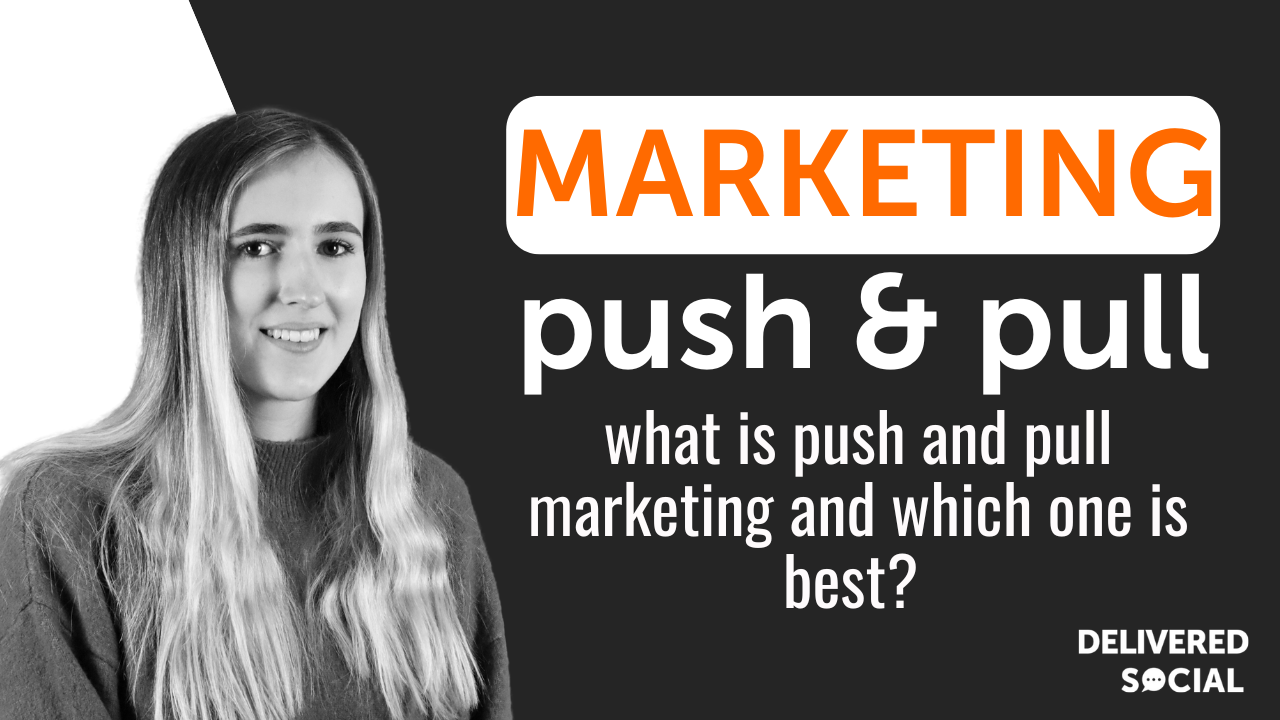
The world of marketing can be a confusing place at times. There seems to be so much jargon and specific phrases that you don’t see used anywhere else. One such phrase is ‘push and pull marketing’. It’s widely thought that the terms push and pull largely encompass all marketing strategies. A strategy is usually one or the other. But what exactly does this phrase mean? In this blog post, we’ll be going through pull vs push marketing, what they mean, and which one is best to use. So, if you want to find out more about this hot topic in marketing, keep on reading…
What is push and pull marketing?
First up, we’ll take a closer look at the definitions of pull and push marketing, and the ways in which they are different. Essentially, push marketing is a strategy that involves pushing a product onto a consumer that isn’t directly looking for it. On the other hand, pull marketing involves marketing something to a customer that is actively looking for it. Now, we’ll take a closer look at the definitions:
Push marketing definition
So, what is push marketing? This is a marketing strategy that involves directly targeting a customer with advertising such as TV ads, online ads, billboards, cold calling, and other methods of active promotion. The aim is to push a product or service that the customer isn’t actively seeking. So, the marketing materials need to encourage them to become interested in the product where they eventually make the move to purchase it.
Most of these methods are to do with marketing in real life, for example as the customer goes about their daily business, driving, watching TV, and so on. How does it translate to the world of digital marketing, which is becoming more and more important in the modern world? The answer is, in a similar way! Tactics such as cold emailing and display advertising, where ads appear on actual websites usually as a banner or sidebar, are the most common examples of push marketing in action in the online world.
Overall, where a push marketing strategy is used, the aim of the marketers is to literally ‘push’ online or offline what they are selling to consumers. It’s often the strategy of choice for new brands with a younger target audience. This is because they have not yet established a market presence or a recognisable brand. They need to push their product at consumers in order to build up a loyal following. It also works with fast-moving gods that are likely to be trendy for a short amount of time. It can be very effective for moving goods quickly, especially if they are a trend that the consumer is aware of, but hasn’t considered purchasing themselves until they are presented with the opportunity to!
Push marketing examples
Here are a few examples of what push marketing can look like. Even if you’re not a marketer yourself, you’ve probably experienced at least a few of them!
- Cold emails. Have you ever received an email from a mailing list you don’t remember signing up to? This is a prime example of this technique which is designed to improve brand awareness!
- Display advertising with a colourful and eye-catching banner on a website, for example a news or games site
- Face-to-face sales in a shop. This is common for showrooms such as cars, kitchens, bathrooms, and so on. Have you ever been persuaded into buying something you didn’t even come in for?
- Point-of-sale advertising, such as name-brand displays in a shop. They can catch your eye with videos of the product in action, which is a common technique.
- Great packaging design which is designed to stand out from everyone else and draw your eye to it.
[code_snippet id=6]
Pull marketing definition
On the other hand, pull marketing is a strategy that is essentially the opposite of push marketing! Here, consumers are actively seeking out the goods that are being marketed. They will already know that it’s this product that they want. For example, they may have purchased from the brand before, know that it has a good reputation, and so on. The aim of this strategy is to gain brand loyalty from customer, who view them as the number one choice for value, quality, and customer satisfaction.
A brand can position itself in this way through a number of advertising techniques to increase a customer’s exposure to them and what they offer, and to set themselves apart from the competition. This could be through techniques such as SEO (search engine optimisation) and paid ads to ensure that a customer doesn’t forget about the brand. But, a brand’s quality and reliability can also be put across through genuinely useful and unique content such as blog posts, social media posts, and videos. Whatever strategies are used, the number one aim is to encourage customers to remain loyal and shop at the brand more than once.
Pull marketing examples
Pull marketing works both online and offline, but it is increasingly being used more in the digital marketing space. This is because this tends to be the place that offers the most access to customers, and so the most opportunities to encourage brand loyalty. Here are a few examples:
- Pay Per Click (PPC) campaigns to directly target the people who are most interested in the brand or the products that it offers.
- SEO strategies can help a brand show up in the search results of organic searches on Google and other search engines. If a brand ranks highly, they are more likely to be positioned as a quality and trustworthy brand.
- Social media marketing is effective for building awareness of a brand on platforms like Instagram, Facebook, Twitter, TikTok, and so on.
- Writing blogs and sharing other types of quality content is a great way to show customers that you are a brand with valuable knowledge to share. It also helps to position a brand as trustworthy and a market leader.
Push and pull marketing: which one is best?
When it comes to which is the best strategy to go for out of push and pull in marketing, the short answer is that it really depends! Most companies tend to go for a mixture of the two strategies, in order to target as many customers as possible. There is no straight answer when it comes to which one is best because no two marketing strategies can ever be the same. Most companies tend to use a combination, especially if they are a newer brand.
Most brands can’t use pull marketing alone, because not all of their target customers will already be aware of them. They will need to do some push marketing in order to et their products out there and make their target customers aware of them in the first place. As brands do become more established, their strategies tend to move towards favouring pull marketing, as this is what encourages repeat customers. For most businesses, getting as many repeat customers as possible is the goal, as it reduces overall marketing spend and general costs.
Overall, both push and pull marketing strategies have their pros and cons. Of course, different strategies will work for different businesses. There’s no one firm answer when it comes to which is better. Every individual business needs to work on a unique strategy, involving trial and error, to figure out what is best for them. And, for the majority of businesses, this is a combination of marketing strategies that work in harmony to drive results!
Enjoyed this post? Check out the rest of our blog page to find out more marketing tips.
Interested In Working Together?
Introducing Delivered Social. We’re The Most-Rated Digital Agency In Surrey & Hampshire – We’ve Got To Be Doing Something Right.
Delivered Social is a digital marketing agency with one mission—to help businesses grow. We’re famous in Guildford and Portsmouth for our social clinics. We believe in free advice. We build lasting relationships because our team prides itself on being helpful, which our clients appreciate.
If you are looking for a new website or an agency to manage your social media presence, we can help.
If you need something slightly different, here's a super handy list of all our services, or you can always email us.





















